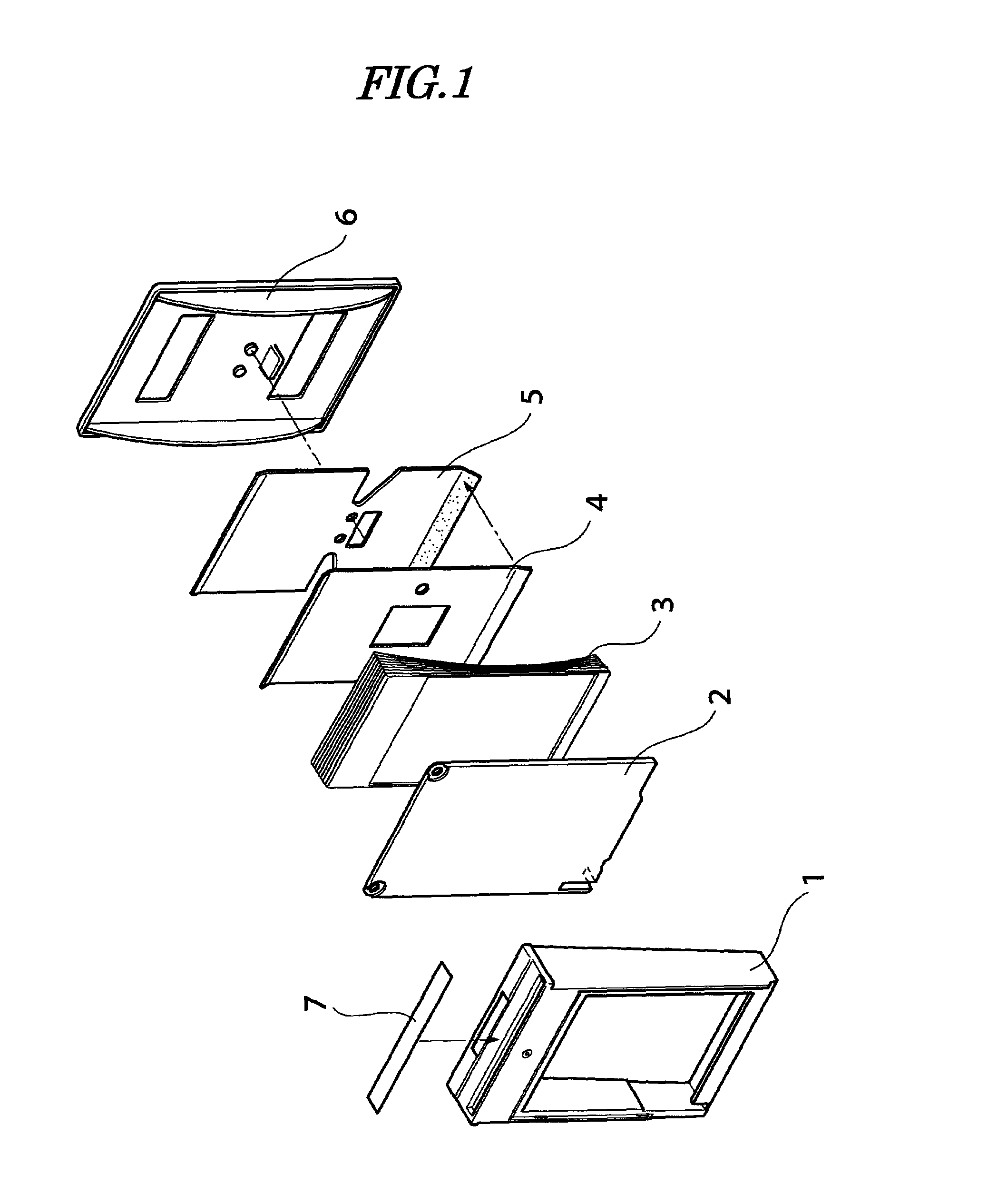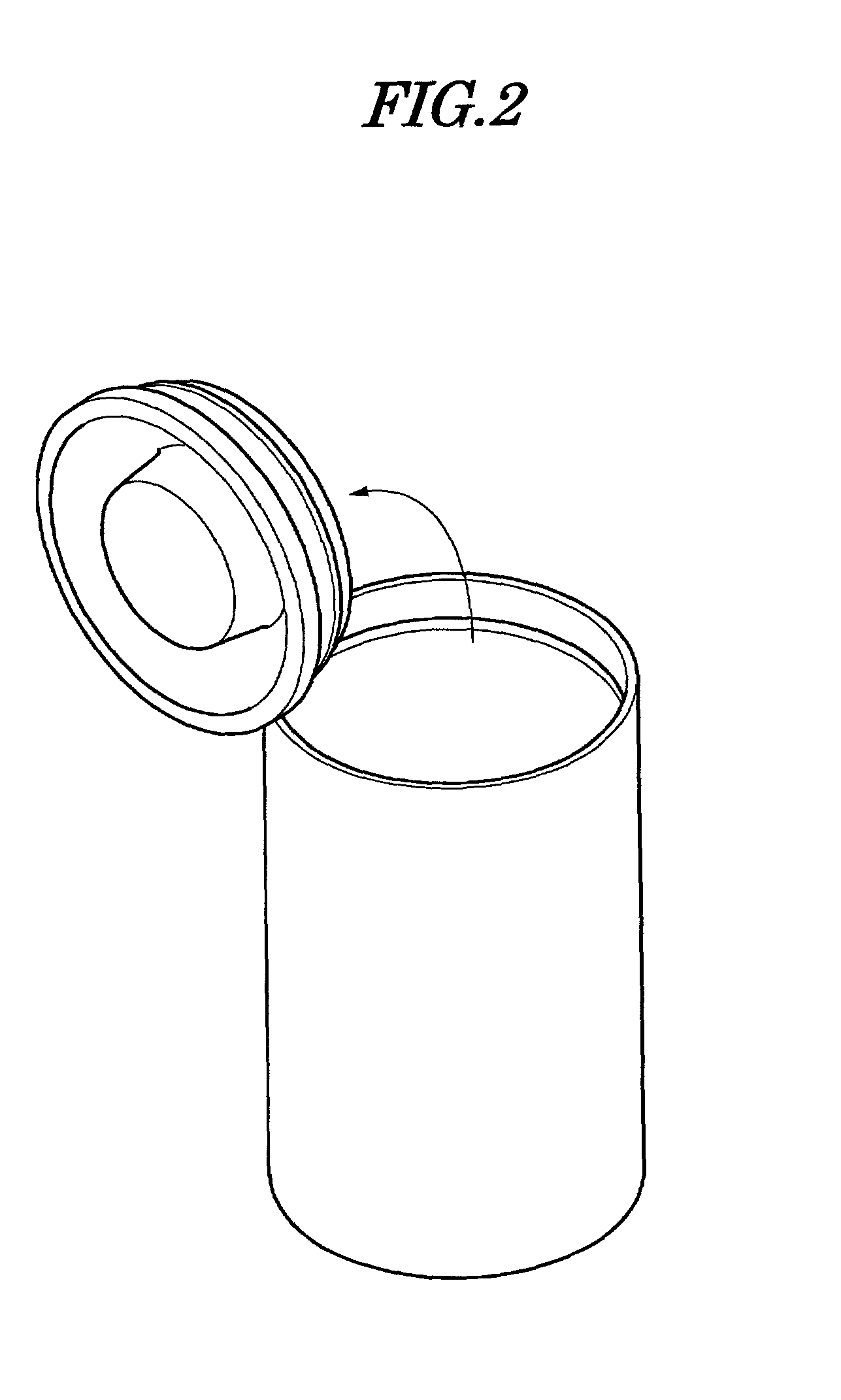Molded product for light-sensitive material, moisture-proof container for light-sensitive material and light-sensitive material package
a technology for moisture-proof containers and light-sensitive materials, which is applied in the direction of rigid containers, pipe laying and repair, and containers preventing decay, etc. it can solve the problems of imposing a large environmental burden, and achieve the effect of improving the performance of molded products, mechanical performance, and suppressing the main factors causing an adverse effect on photographic properties
- Summary
- Abstract
- Description
- Claims
- Application Information
AI Technical Summary
Benefits of technology
Problems solved by technology
Method used
Image
Examples
example 1
[0156] As a starting material a waterproof paper for printing paper was used that was formed by laminating a polyolefin resin on a base paper that had been produced for printing paper using hardwood bleached kraft pulp (LBKP) having a weight-average fiber length of 0.7 mm measured using a FS-100 measuring machine manufactured by Kajaani Co. This waterproof paper for printing paper was formed by laminating 25 parts by weight of a PE resin on 75 parts by weight of the base paper. The waterproof paper for printing paper was broken using a pin mill to give broken sample 1. Broken sample 1 was compression-kneaded using a pellet mill as described in the above-mentioned detailed production process example step (3) to give compact pellets, which were subsequently broken in a turbomill as described in the above-mentioned detailed production process example step (4) to give broken sample 2. The weight-average fiber length of broken sample 2 was found to be 0.45 mm by microscope measurement.
[0...
example2
[0164] A moisture-proof case main body for housing FUJICOLOR SUPERIA (registered trademark) 400 was molded using the paper resin pellets produced in Example 1.
[0165] The die had a four-branch valve gate system with a valve diameter of 2 mm. The die temperature was 70.degree. C. The molding machine was a Sumitomo SG180. The paper resin temperature was 170.degree. C.
[0166] For a lid for the main body, elastic paper resin pellets were prepared by mixing 100 parts by weight of the broken sample 2 produced in Example 1, 20 parts by weight of a PP resin, and 24 parts by weight of an elastomer, and introducing elasticity in accordance with the methods of the above-mentioned detailed production process example steps (5) and (6). The paper resin lid was molded using the above-mentioned paper resin pellets in a four-branch lid die under the same molding conditions as those used for the main body case.
[0167] The lids were used for all the main body cases having different compositions, and the ...
example 3
[0172] Broken material 2 was obtained in the same manner as in Example 1 using base papers that gave cellulose fiber weight-average fiber lengths after breaking of 0.3, 0.50, 0.70, 0.90, and 0.95 mm. Paper resin pellets were produced according to the above-mentioned detailed production process example by mixing 100 parts by weight of the broken material 2 with 47 parts by weight of a PP resin. A 135 format film case was molded in the same manner as in Example 2 using the paper resin pellets, and the moldability and the moisture permeability were evaluated. The results are given in Table 5.
5TABLE 5 Weight- Moisture Photographic average fiber permeability property length mm g / m.sup.2 .multidot. day .DELTA.Dmin Moldability Note 0.25 4.0 0.050 D Cellulose easily decomposed by heat 0.30 4.0 0.020 A 0.45 10.0 0.010 A 0.50 10.3 0.010 A 0.60 10.4 0.090 C 0.70 10.9 0.090 D Injection pressure high
[0173] When the weight-average fiber length after breaking was less than 0.30 mm, the cellulose f...
PUM
| Property | Measurement | Unit |
|---|---|---|
| weight-average fiber length | aaaaa | aaaaa |
| weight-average fiber length | aaaaa | aaaaa |
| thickness | aaaaa | aaaaa |
Abstract
Description
Claims
Application Information
 Login to View More
Login to View More - R&D
- Intellectual Property
- Life Sciences
- Materials
- Tech Scout
- Unparalleled Data Quality
- Higher Quality Content
- 60% Fewer Hallucinations
Browse by: Latest US Patents, China's latest patents, Technical Efficacy Thesaurus, Application Domain, Technology Topic, Popular Technical Reports.
© 2025 PatSnap. All rights reserved.Legal|Privacy policy|Modern Slavery Act Transparency Statement|Sitemap|About US| Contact US: help@patsnap.com



